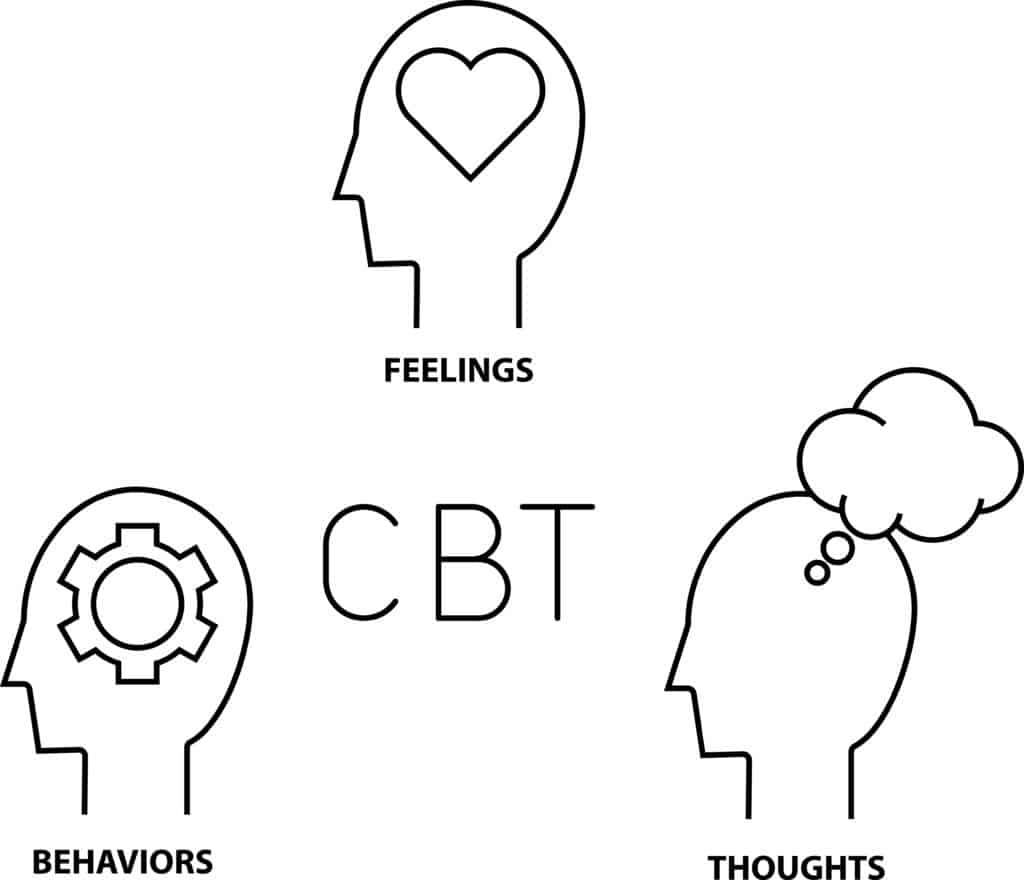Cognitive-Behavioral Therapy: Breaking Bad Habits for Good
You may have done some research on different types of therapy or therapy techniques such as cognitive-behavioral therapy. Cognitive-behavioral therapy is the combination of two different therapies, cognitive and behavioral therapy.

Table of Contents
What is Cognitive-Behavioral Therapy?
Cognitive-behavioral therapy is a very popular form of therapy stating that what people believe affects how they act and feel. It says that if we modify thoughts we can modify Albert Bandura and B.F Skinner created behavioral therapy, along with Robert Ellis created rational emotive behavior therapy and Aaron Beck created cognitive therapy. Cognitive-behavioral therapy was formed from the combination of these therapies and theorists.
What Is Cognitive-Behavioral Therapy Helpful For?
Cognitive-behavioral therapy is one very commonly used perspective in therapy to help individuals with the following mental health disorders: (Kaczkurkin & Foa, 2015)
- Eating Disorders
- Post-Traumatic Stress Disorder (PTSD)
- Obsessive-Compulsive Disorder (OCD)
- Generalized Anxiety Disorder
- Social Anxiety Disorder
- Phobias
Cognitive-behavioral therapy is for more than just individuals with these disorders. It can help you work on your time management skills, pain management, sleep, being on time for events, etc.
Fear Conditioning
“”The serotonergic system modulates Pavlovian fear conditioning”, serotonin imbalance is
associated with anxiety and depression. “(Bauer, 2015)
Studies have shown that taking control of your mindset can dramatically affect your outcomes
in life. The expression “it’s all in the mind” isn’t just empty words! One’s whole outlook is defined by how one thinks, and it also plays a very important role in determining the habits that one imbibes.
Bad habits do not just spring out from nowhere.
They are combinations of external factors that trigger actions, which are then meant to satisfy a want or a drive. They are also the result of neurological factors.
Scientists have traced the development of habits to the part of the brain called the basal ganglia, which is also involved in the creation of emotions and memories.
This is also the part of the brain involved in recognizing and enacting patterns. Conscious decision-making is situated in a different part of the brain, the prefrontal cortex. Ideally, conscious decisions are meant to balance the impulsiveness of emotional thinking.
However, when habits form, the involvement of the prefrontal cortex in our actions decreases. It is as if this part of the brain freezes.
This is why habits are often tied to patterns and memories, and why bad memories and emotions tend to produce bad habits. Conversely, healthy emotions caused by a positive outlook tend to prevent the creation of bad habits.
But of all emotions, there is one that tends to be most potent in the production of bad habits — fear. In psychology, the topic of “fear conditioning” has gained a lot of attention.
The 2007 edition of Psychoneuroimmunology mentions that fear conditioning is “learning that a neutral stimulus predicts the appearance of an aversive event”.
For example, the onset of a long weekend (a neutral stimulus) is associated with the onset of boredom (an aversive event), so one may decide to go on an indulgent shopping spree to kill time — a potentially bad habit that stems out of a trigger and the drive to avoid fear.
Other Useful Articles:
- Is Anxiety a Disorder? Exactly What You Need To Know
- Dealing With Anxiety: Here’s The Right Way to Do It!
- What Anxiety Causes: The Silent Killer
“Fixing” Bad Habits — Cognitive Behavioral Therapy
The shopping spree example is a very straightforward one, but most habits are not like that. Most arise from complex mental processes, so much that they are already hard-wired into a person’s mind. “Fixing” these habits would mean having to untangle the mind.
Cognitive Behavioral Therapy (CBT) is one of the most effective tools that can help resolve runaway bad habits. It is a form of psychological treatment that is currently being employed to help with a range of issues, from depression to anxiety, to addiction. Mental concerns, no matter how big or small, fall within the province of CBT.
In fact, the term “cognitive-behavioral therapy” in itself is an umbrella term, which helps us understand how it can cover so many different psychological issues.
There are different techniques that can be mixed and matched to achieve the desired effects on the client. Some techniques include multimodal therapy (focused on the senses). Dialectical behavioral therapy (focused on addressing thoughts and emotions), and rational emotive behavior therapy (focused on identifying incorrect beliefs)
One of the interesting things about CBT is the fact that it recognizes the way most psychological problems are caused — by “unhelpful” ways of thinking.
Which results in the mind misinterpreting and incorrectly reacting to triggers. Cognitive-behavioral therapy recognizes that these ways of thinking did not come naturally. They were learned, and therefore they could be “fixed” by replacing them with other thinking patterns.
Positive Growth
Cognitive-behavioral therapy has been known for enticing positive growth in the structural levels of the brain.
A 2004 study found that while conventional medical treatment relating to emotions. Such as the use of antidepressants — caused a dampening of the brain’s limbic system (the part of the brain involved in the processing of emotions) — CBT works by calming the activity in the brain’s cortex.
This means that instead of reducing emotions, CBT contributes by helping the therapee properly process emotion. This is a healthier approach, with a lower chance of relapse.
Rewire Thoughts
Cognitive-behavioral therapy takes a two-pronged approach to rewire a person’s thought process for the better.
First, it uses logic and science in that it entices the person to use learning and problem solving to cope with difficult scenarios — situations that, unchecked, could lead to the recurrence of the psychological issue that we are seeking to fix.
The individual attending therapy is enticed to learn various skills to increase his self-confidence and to increase his arsenal against the things that could trigger the unwanted habit.
For example, one could take up fitness activities in order to ward off cravings. Or, one could take up skills like bookkeeping to boost one’s financial awareness and prevent overspending.
On the other hand, CBT also uses introspection and reflection as a means to help eliminate ill habits.
These are methods of understanding one’s own thought processes and motivation, through conversations with the therapist. Aside from helping find the root of one’s behavioral concerns, these techniques also have neurological effects.
MRI scans show that the prefrontal cortex shows heavy activity during introspective and reflective sessions. This means the mind’s decision-making center is stimulated, helping it regain control over the more impulsive limbic system.
This introspective and reflective technique is in keeping with the origins of the concept of cognitive behavioral therapy itself. According to sources, the main pioneers of CBT looked to Stoicism as the precursor to their technique. (Robertson, 2010). Stoicism is famous for its view that while anything can happen to a person, how that person reacts to such events (whether in a productive or harmful way) will depend on that person’s mindset alone.
Fear and CBT
Perhaps more importantly, cognitive behavioral therapy also recognizes that fear can be a debilitating issue. Something that easily hijacks our thought process.
This happens on a neurological level, as the brain’s cortex shuts down. In a way, this is a survival move — when all brainpower feed is diverted to instinct instead of conscious thought, one can react and find short-term solutions faster.
However, in the long run, this survival instinct causes a negative chain of results as anxiety becomes the norm and the cortex fails to resume its normal functions.
Cognitive-behavioral therapy also recognizes the different ways fear affects our mind and body.
Fear causes the release of stress hormones like cortisol and norepinephrine that prime the body for the fight-or-flight response.
This causes mental stress, which in turn causes the inability to properly decide for long-term benefits.
Getting Relief Naturally
A cognitive-behavioral therapist can help a person learn calming techniques to relax the mind and body, for use when the gripping sensation of fear pushes one to bad habits once more.
Breathing techniques, for example, can help disengage the sympathetic fight-or-flight system and shift the controls over to the parasympathetic side of the nervous system. This is the rest-and-digest system that puts a brake on the stress response of fear and can have immediate effects such as the lowering of blood pressure and altering of the blood’s pH.
In order to further dispel fear and create a positive atmosphere, CBT also works by creating reinforcement systems that serve to strengthen the effects of the good behavior that is seeking to replace the bad habit.
These reinforcements can be as simple as an encouraging word from the therapist, or as substantial as demonstrating how one’s positive behavior serves to improve one’s life.
CBT, however, is not meant to shelter one from situations that provoke negative emotions.
On the contrary, it seeks to gradually increase your exposure to these negative emotions so that you may be able to cope with them better.
Imagery-based exposure, for example, one of the CBT techniques that involve visualizing a negative memory, helps to reduce “avoidance coping” (essentially the tendency to run away from problems). By decreasing the level of distress caused by these negative memories.
Talking to a Friend
Most people think of a psychological intervention as a last resort. “What would my friends think about me when they learn I’m seeing a shrink?” For others, they feel uncomfortable having another person pick his brain, analyzing his quirks, his tics, and every word he says. This is why so many people would rather suffer while struggling with the effects of their bad habits, rather than get help.
But the idea of cognitive behavioral therapy defies these stereotypes. The whole idea of CBT is that the client and the therapist would work as one, helping each other understand the issues that lie at the core of the unwanted behavior, in order to find the most effective way to treat it. It’s not much different from talking to a friend in order to come up with a solution to a problem.
Dig Deeper
In CBT, the therapist seeks to learn more about what is going on in the life of the client, so that he can understand how these events help shape the client’s response to things. This is a more holistic and realistic approach, unlike some other types of therapy that only seek to understand the specific events that surround the psychological issue in question.
Ideally, cognitive behavioral therapy aims to help the individual become his own therapist. While there are formal therapy sessions, there are also “homework” or tasks that need to be performed outside the therapy session.
These tasks are meant to further explore one’s thoughts and actions and can be used to develop skills necessary for forming new and better habits. Unlike a doctor issuing prescriptions that the patient knows nothing about, a cognitive-behavioral therapist seeks to give his client the keys to his own healing by helping him understand every step of the way.
Going on a cognitive behavioral therapy session is like talking to a friend. It is done in a healthy environment, free of judgment.
Here, we are free to talk about and reflect on the events of the day, our current thoughts, and our plans for the future. And the therapist helps us find the path forward by helping us think of the best course of action.
In essence, it echoes Paul’s exhortations in Philippians 4:8 — “Finally, brothers, whatever is true, whatever is noble, whatever is right, whatever is pure, whatever is lovely, whatever is admirable — if anything is excellent or praiseworthy — think about such things.”
CBT and Christianity’s Role in Change
Cognitive-behavioral therapy is well-known because it is simple, practical, and effective. To Christians, CBT is also preferable because it makes sense in the light of Scriptural thought.
Behavioral therapy techniques are geared towards helping people make the right decision in times of stress and temptation. Looking towards mental clarity in order to resolve psychological conflicts and get rid of external triggers. Again, this is one with the Bible’s words in Romans 12:2 — to “not be conformed to this world but be transformed by the renewal of your mind”.
Cognitive-behavioral therapy is simple, practical, and effective because it takes a common-sense approach to things. It does not mire the person in complicated psychological processes, though these are definitely at the core of things.
This is similar to how the Bible does not mire us in theological doctrines or philosophies but only aspires to give us the simple truth of a clear mind and a clear heart based on faith in God and his works.
20 Anxiety Bible Verses to Fuel Your Day
Opening New Doors
The ability to maintain a clear mind and a clear heart does not only help one surpass the tensions of daily life and the temptations of bad habits.
In addition, it also helps open new doors in the world. While it is true that one can hardly advance in life when burdened by a distorted mindset and the behavioral clutches of bad habits, the exact opposite is also true. That is, a person who gains clarity of mind and freedom from the bindings of external stressors also finds a way to advance in life that few others find.
In a sense, being rid of this fear is not really something new. It’s simply a return to our base state. We were not born with fear — as 2 Timothy 1:7 states, “for God hath not given us the spirit of fear; but of power, and of love, and of a sound mind.”
Our years on earth have taught us fear, and maybe it’s now hard for us to imagine how to live without it and its effects — but if we really want to move forward, we have to.
A clear mind helps a person see the truth not only in his surroundings but also in himself. A clear heart allows him to move forward with a clean conscience, knowing that what he does is right.
In the end, both Scripture and cognitive behavioral therapy aim to dispel the same things — fear, and the many mental processes that go with it. These are also the same things that we need to eliminate if we are to progress in life.
With this out of the way, we are free to live to our full measure. To take root and bear fruit, and to spread the blessings we receive to others, instead of squandering them in misplaced beliefs.
All we have to do is to take that big first step forward. In order to recognize that we need help with what we are going through, and to search for that help.
Today, there are many licensed cognitive behavioral theorists who can kickstart this transformative process. If one isn’t readily available, there are always the words of the Scripture to live by.
The aid may come either from a therapist’s couch or from the pages of the Bible. Either way, when we find it, we’re one step closer to our goals.
Resources:
Kaczkurkin, A. N., & Foa, E. B. (2015). Cognitive-behavioral therapy for anxiety disorders: an update on the empirical evidence. Dialogues in clinical neuroscience, 17(3), 337–346. https://doi.org/10.31887/DCNS.2015.17.3/akaczkurkin
https://www.npr.org/2012/03/05/147192599/habits-how-they-form-and-how-to-break-them
https://jamanetwork.com/journals/jamapsychiatry/fullarticle/481941
https://academic.oup.com/brain/article/125/8/1808/332451
https://www.npr.org/2010/12/06/131734718/just-breathe-body-has-a-built-in-stress-reliever
https://www.psychologytoday.com/us/blog/in-practice/201212/cognitive-behavioral-therapy-techniques-work
https://www.verywellmind.com/what-is-cognitive-behavior-therapy-2795747
https://www.apa.org/ptsd-guideline/patients-and-families/cognitive-behavioral
https://www.sciencedirect.com/topics/neuroscience/fear-conditioning
https://www.whatchristianswanttoknow.com/is-behavioral-therapy-biblical/
Originally posted 2020-07-27 21:58:02.
Megan Santiago
Latest posts by Megan Santiago (see all)
- How to break a Fever - March 10, 2024
- 8 Natural Research-Backed Ways to Cope if You’re a Hypochondriac - January 3, 2024
- DHA Deficiency Symptoms: Superior Nutrients for Mental Health - January 3, 2024

